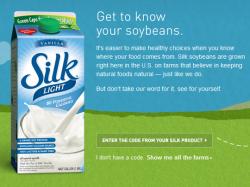Silk Soymilk Makes It Easy To Find Out Where Its Soybeans Come From
November 16, 2010 | 3 min to read

BROOMFIELD, Colo. — Recent research shows that 75 percent of U.S. consumers like seeing where their food comes from1. To answer the call, Silk soymilk has introduced a new website, www.silksoymilk.com/traceit/ that allows consumers to easily trace the soybeans in a carton of milk back to the location of the farm where the soybeans in that product were grown.
The Silk website is the first of its kind to allow consumers to trace soy. The site also provides information about how Silk soymilk is made and Silk’s commitment to using only soybeans that do not contain genetically modified organisms (GMOs).
“Many consumers want to know where the ingredients used in the foods and beverages they buy come from and how they are produced,” said Craig Shiesley, vice president for Silk. “Silk is continuing to broaden our commitment to transparency about our products, and this new website provides a simple way for consumers to find out more about our soybeans and other foods they eat.”
In addition to tracing the origins of the soybeans in their soy products milk, consumers can use the website to test their food IQ with quizzes and polls and to join Facebook discussions about Silk, yogurt, creamer and other food topics.
Find the Location of Your Farm
Silk uses only whole-harvested, non-GMO soybeans that are grown in the United States. Consumers can visit the new traceability website and enter the manufacturer’s code and expiration date from any carton of Silk soymilk to find the U.S. counties where their soybeans were grown. The site includes factoids such as the county population and the current stage of soybeans on the farms there – beans up, flowering, bean growth or harvest.
Consumers who don’t have a product code still can find information about the farms where Silk sources its soybeans, including a U.S. map that shows where farms are located. The website also features a photo gallery, where consumers can view pictures of the soybean farms.
Test Your Food IQ
Does Jackfruit grow on a bush, tree or vine? Do food shoppers choose which produce to buy based on what’s in season or how much it costs? Consumers can test how much they know about food and how their food-buying habits stack up against other shoppers by completing quizzes and polls on the new site. Silk will periodically update the site with new quizzes and polls.
For those who want to learn more about non-GMO foods, the site also provides information about the differences between GMO and non-GMO and why Silk uses only non-GMO soybeans.
“Consumers may be surprised by some of the things they don’t know about the foods they eat, including the fact that about 80 percent of food processed in America contains some form of GMOs2,” added Shiesley. “That’s why we also created a video which explains the ins-and-outs of the new site – consumers can learn how to use our new traceability tool while also discovering interesting facts about where their soybeans come from.”
Silk enrolled in the Non-GMO Project’s Product Verification Program earlier this year. The Non-GMO Project is the nation’s first system designed to test whether a product has met defined standards for the absence of GMOs.
To learn more about Silk’s soybean sourcing standards, please visit http://silksoymilk.com/content/pdf/SilkSoybeanSourcingProgram.pdf.
News about the latest updates on all the brand’s efforts to produce soymilk sustainably and responsibly can be found at www.silksoymilk.com, or by visiting Silk on Facebook or Twitter.
ABOUT SILK
Silk Soymilk was launched in 1996 and is the best-selling soymilk brand in the country. Not only do Silk products taste delicious, a cup of Silk soymilk contains as much calcium as a cup of milk and is loaded with soy protein, which when consumed as a part of a diet low in saturated fat and cholesterol may reduce the risk of heart disease3. Silk was founded on a promise to make the world a healthier place. We began by bringing soymilk mainstream, allowing more people everywhere to enjoy soy’s wholesome, natural nutrition. We recently introduced almondmilk as the next step in our proud tradition of good health and great taste. For more information, visit www.silksoymilk.com or www.silkpurealmond.com.
1 A recent FoodMind survey has found that three quarters (75%) of shoppers like seeing where their food comes from ("organic," "natural" and "sustainable farming practices") (PR Newswire (U.S.), March 8, 2010)
2 http://www.gmo-compass.org/eng/home/
3 In 1999 the FDA issued a health claim for soy and its role in promoting cardiovascular health. Food and Drug Administration. Food labeling, health claims, soy protein, and coronary heart disease. Fed Reg 1999;57:699-733.
Source: Silk Soymilk
